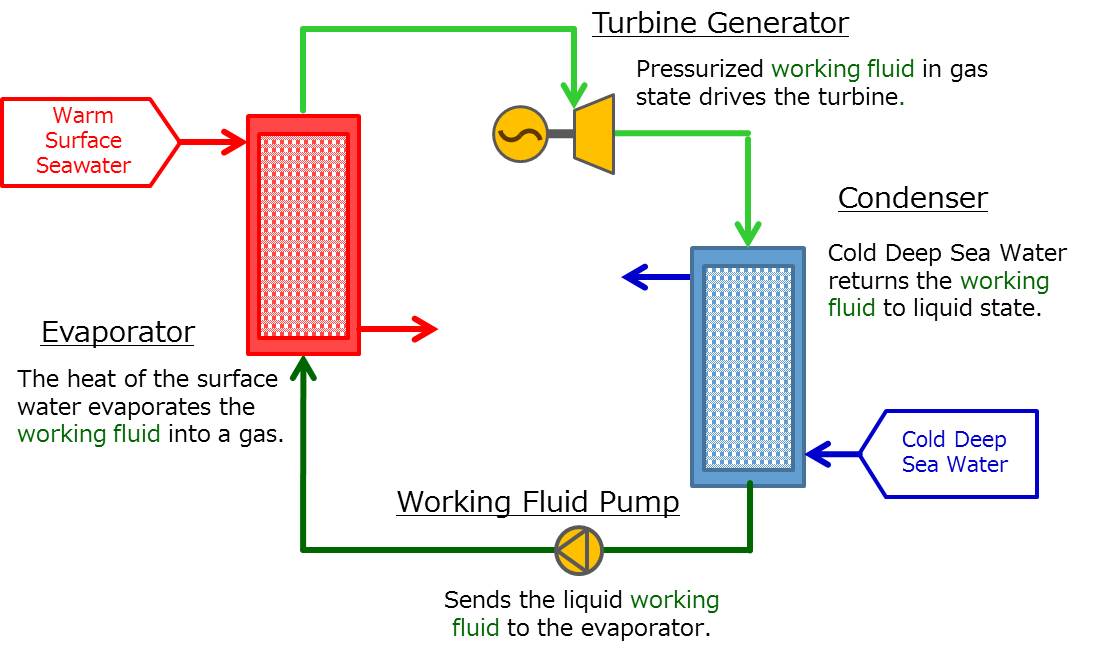OTEC Basics

Ocean Thermal Energy Conversion (OTEC) technology uses a turbine generator to create renewable energy from the temperature difference between cold, deep seawater circulating in the ocean and surface seawater warmed by the sun. In order to produce power with the low temperature range, a working fluid with low boiling point is used.
The amount of energy created is dependant on the amount of water available to cool or heat the working fluid. The Okinawa OTEC project has a maximum capacity of 100kW, but since it does not always have access to the maximum capacity due to other seawater users, will often produce less electricty. This is due to the previous use of water by local industries and the Okinawa Deep Seawater Research Center, and does not hinder the project's goal of demonstration and testing.
Visit us to learn more about our current and future projects.
OTEC Q&A
Q: What are the characteristics of OTEC power generation?
A: Since seawater temperature does not change rapidly, the power output is stable and prediction of potential power generation is more reliable than many other renewable sources. The seawater pumped in for use at an OTEC plant can be used for many different applications, offsetting the cost of initial pipeline investment.
Q: What is the history of OTEC?
A: Physicist Jacques-Arsène d'Arsonval of France first proposed the idea in 1881. Development has been intermittent since, but in response to the recent growth in interest in renewable energy, development has increased in countries such as the United States, France, China, and Japan.
Q: Where is OTEC possible?
A: With current technology, an annual temperature differeance of 20℃ or more is needed. This difference is found in sub-tropical and tropical regions such as the Okinawa, Kuroshio, and Ogasawara areas in Japan.
Q: What is the potential of OTEC?
A: The potential power generation in Japan is 5,952MW within 30km of the shore. With no offshore distance limitation the potential is 173,569MW (Both in areas where the seawater temperature difference is 20 ℃ or more. The impact on marine environment is negligible due to comparatively small water intake).
In Okinawa, the potential for power generation is 2,797MW within 30km and 79,992MW without offshore distance limitation. Since the current power generation of Okinawa is 2,000MW, the potential could cover all needs in Okinawa. Source: NEDO report “A Business Understanding of Ocean Energy Potential” March 23, 2010
Q: What is the power generation cost?
A: The first (July 2010) and second (April 2014) editions of the NEDO Renewable Energy White Paper contains calculations of power generation costs by the Ocean Energy Resource Utilization Promotion Organization (OEA-J) Ocean Thermal Energy Conversion Subcommittee. The calculated figures are around 20 yen/kWh for 10MW-class OTEC, and 10 yen/kWh for 100MW-class, which are power generation costs comparable to existing thermal power generation and nuclear power generation.
This cost of power generation was scrutinized by setting the installation area around Okinawa in NEDO's “Next Generation Ocean Energy Power Generation Technology Research and Development (Ocean Temperature Difference Power Generation)” (FY2011-2014). For this calculation, in fiscal year 2012’s Okinawa Prefecture “Demonstration Project of Power Generation Used for Advanced Deep Seawater Utilization” the three companies that built the OTEC demonstration test facility, IHI Plant Construction Co., Ltd., Xenesys Inc, and Yokogawa Electric, along with Japan Marine United Co., Ltd., a leading shipbuilding company, were involved in calculating the power generation costs of 1MW and 10MW-class power plants. When commercialized, the cost of generating electricity was calculated to be 31.0 to 44.5 yen/kWh for the 1MW-class, and 18.6 to 23.5 yen/kWh for the 10MW-class, which is nearly the same as the above NEDO Renewable Energy Technology White Paper.
In the NEDO "Ocean Energy Power Generation System Demonstration Research (Ocean Temperature Difference Power Generation)” (2014-2017), Japan Marine United Co., Ltd. scrutinized costs through review of the layout within floating structures, etc. for 10MW-class, and the calculated power generation cost of the 10MW-class was revised to 20.7 to 26.3yen/kWh.
Based on the five-year operating results of FY2013-2017 within the Okinawa Prefecture Demonstration Project, the operation and management costs of the 1MW-class OTEC plant were calculated. As a result, operating management costs are estimated to be around 4.2 yen/kWh, and the cost of generating electricity is 29.7 yen/kWh, indicating that the cost may be reduced by approximately 25% compared to the calculations in the above NEDO projects.
In addition, factors contributing to cost reduction of power generation in the future are summarized in Chapter 3 of the report of this project. See below for more information (in Japanese).
